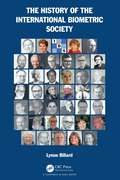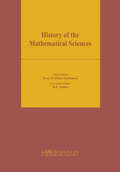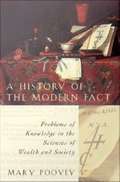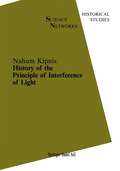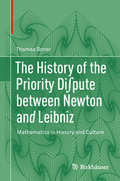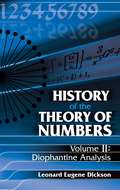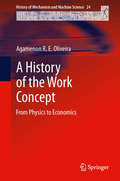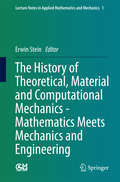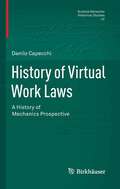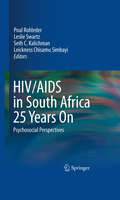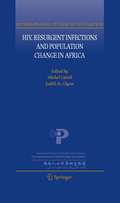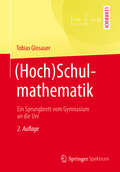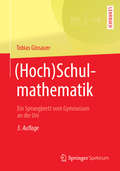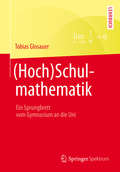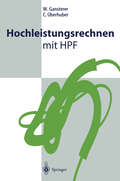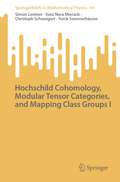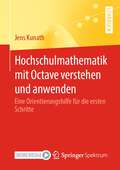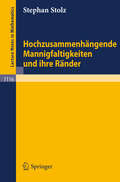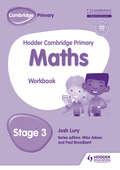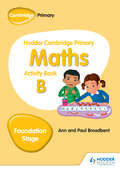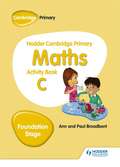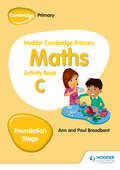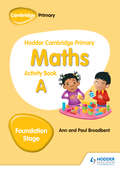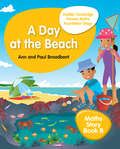- Table View
- List View
The History of the International Biometric Society
by Lynne BillardThe International Biometric Society (IBS) was formed at the First International Biometric Conference at Woods Hole on September 6, 1947. The History of the International Biometric Society presents a deep dive into the voluminous archival records, with primary focus on IBS’s first fifty years. It contains numerous photos and extracts from the archival materials, and features many photos of important leaders who served IBS across the decades. Features: Describes events leading up to and at Woods Hole on September 6, 1947 that led to the formation of IBS Outlines key markers that shaped IBS after the 1947 formation through to the modern day Describes the regional and national group structure, and the formation of regions and national groups Describes events surrounding the key scientific journal of IBS, Biometrics, including the transfer of ownership to IBS, content, editors, policies, management, and importance Describes the other key IBS publications – Biometric Bulletin, Journal of Agricultural Biological and Environmental Statistics, and regional publications Provides details of International Biometric Conferences and key early symposia Describes IBS constitution and by-laws processes, and the evolution of business arrangements Provides a record of international officers, including regional presidents, national group secretaries, journal editors, and the locations of meetings Includes a gallery of international Presidents, and a gallery of Secretaries and Treasurers The History of the International Biometric Society will appeal to anyone interested in the activities of our statistical and biometrical forebearers. The focus is on issues and events that engaged the attention of the officers of IBS. Some of these records are riveting, some entertaining, some intriguing, and some colorful. Some of the issues covered were difficult to handle, but even these often resulted in changes that benefited IBS.
The History of the International Biometric Society
by Lynne BillardThe International Biometric Society (IBS) was formed at the First International Biometric Conference at Woods Hole on September 6, 1947. The History of the International Biometric Society presents a deep dive into the voluminous archival records, with primary focus on IBS’s first fifty years. It contains numerous photos and extracts from the archival materials, and features many photos of important leaders who served IBS across the decades. Features: Describes events leading up to and at Woods Hole on September 6, 1947 that led to the formation of IBS Outlines key markers that shaped IBS after the 1947 formation through to the modern day Describes the regional and national group structure, and the formation of regions and national groups Describes events surrounding the key scientific journal of IBS, Biometrics, including the transfer of ownership to IBS, content, editors, policies, management, and importance Describes the other key IBS publications – Biometric Bulletin, Journal of Agricultural Biological and Environmental Statistics, and regional publications Provides details of International Biometric Conferences and key early symposia Describes IBS constitution and by-laws processes, and the evolution of business arrangements Provides a record of international officers, including regional presidents, national group secretaries, journal editors, and the locations of meetings Includes a gallery of international Presidents, and a gallery of Secretaries and Treasurers The History of the International Biometric Society will appeal to anyone interested in the activities of our statistical and biometrical forebearers. The focus is on issues and events that engaged the attention of the officers of IBS. Some of these records are riveting, some entertaining, some intriguing, and some colorful. Some of the issues covered were difficult to handle, but even these often resulted in changes that benefited IBS.
A History of the Modern Fact: Problems of Knowledge in the Sciences of Wealth and Society
by Mary PooveyHow did the fact become modernity's most favored unit of knowledge? How did description come to seem separable from theory in the precursors of economics and the social sciences? Mary Poovey explores these questions in A History of the Modern Fact, ranging across an astonishing array of texts and ideas from the publication of the first British manual on double-entry bookkeeping in 1588 to the institutionalization of statistics in the 1830s. She shows how the production of systematic knowledge from descriptions of observed particulars influenced government, how numerical representation became the privileged vehicle for generating useful facts, and how belief—whether figured as credit, credibility, or credulity—remained essential to the production of knowledge. Illuminating the epistemological conditions that have made modern social and economic knowledge possible, A History of the Modern Fact provides important contributions to the history of political thought, economics, science, and philosophy, as well as to literary and cultural criticism.
History of the Principle of Interference of Light (Science Networks. Historical Studies #5)
by N. KipnisThe controversy between the wave theory and the emission theory of light early in the nineteenth century has been a subject of numerous studies. Yet many is sues remain unclear, in particular, the reasons for rejecting Young's theory of light. It appears that further progress in the field requires a better grasp of the overall situation in optics and related subjects at the time and a more thorough study of every factor suggested to be of importance for the dispute. This book is intended to be a step in this direction. It examines the impact of the concept of interference of light on the development of the early nineteenth century optics in general, and the theory of light, in particular. This is not a his tory of the wave theory of light, nor is it a history of the debate on the nature of light in general: it covers only that part of the controversy which involved the concept of interference. Although the book deals with a number of scientists, scientific institutions, and journals, its main character is a scientific concept, the principle of interference. While discussing the reasons for accepting or rejecting this concept I have primarily focused on scientific factors, although in some cases the human factor is examined as well. The book is a revised Ph. D. dissertation (University of Minnesota, 1984) writ ten under Alan E. Shapiro.
The History of the Priority Di∫pute between Newton and Leibniz: Mathematics in History and Culture
by Thomas Sonar Patricia Morton Keith William MortonThis book provides a thrilling history of the famous priority dispute between Gottfried Wilhelm Leibniz and Isaac Newton, presenting the episode for the first time in the context of cultural history. It introduces readers to the background of the dispute, details its escalation, and discusses the aftermath of the big divide, which extended well into rThe Early Challengesnd the story is very intelligibly explained – an approach that offers general readers interested in the history of sciences and mathematics a window into the world of these two giants in their field. From the epilogue to the German edition by Eberhard Knobloch:Thomas Sonar has traced the emergence and the escalation of this conflict, which was heightened by Leibniz’s rejection of Newton’s gravitation theory, in a grandiose, excitingly written monograph. With absolute competence, he also explains the mathematical context so that non-mathematicians will also profit from the book. Quod erat demonstrandum!
History of the Theory of Numbers, Volume II: Diophantine Analysis
by Leonard Eugene DicksonThe three-volume series History of the Theory of Numbers is the work of the distinguished mathematician Leonard Eugene Dickson, who taught at the University of Chicago for four decades and is celebrated for his many contributions to number theory and group theory. This second volume in the series, which is suitable for upper-level undergraduates and graduate students, is devoted to the subject of diophantine analysis. It can be read independently of the preceding volume, which explores divisibility and primality, and volume III, which examines quadratic and higher forms.Featured topics include polygonal, pyramidal, and figurate numbers; linear diophantine equations and congruences; partitions; rational right triangles; triangles, quadrilaterals, and tetrahedra; the sums of two, three, four, and n squares; the number of solutions of quadratic congruences in n unknowns; Liouville's series of eighteen articles; the Pell equation; squares in arithmetical or geometrical progression; equations of degrees three, four, and n; sets of integers with equal sums of like powers; Waring's problem and related results; Fermat's last theorem; and many other related subjects. Indexes of authors cited and subjects appear at the end of the book.
A History of the Work Concept: From Physics to Economics (History of Mechanism and Machine Science #24)
by Agamenon R. OliveiraThis book traces the history of the concept of work from its earliest stages and shows that its further formalization leads to equilibrium principle and to the principle of virtual works, and so pointing the way ahead for future research and applications.The idea that something remains constant in a machine operation is very old and has been expressed by many mathematicians and philosophers such as, for instance, Aristotle. Thus, a concept of energy developed. Another important idea in machine operation is Archimedes' lever principle.In modern times the concept of work is analyzed in the context of applied mechanics mainly in Lazare Carnot mechanics and the mechanics of the new generation of polytechnical engineers like Navier, Coriolis and Poncelet. In this context the word "work" is finally adopted. These engineers are also responsible for the incorporation of the concept of work into the discipline of economics when they endeavoured to combine the study of the work of machines and men together.
The History of Theoretical, Material and Computational Mechanics - Mathematics Meets Mechanics and Engineering: Mathematics Meets Mechanics And Engineering (Lecture Notes in Applied Mathematics and Mechanics #1)
by Erwin SteinThis collection of 23 articles is the output of lectures in special sessions on “The History of Theoretical, Material and Computational Mechanics” within the yearly conferences of the GAMM in the years 2010 in Karlsruhe, Germany, 2011 in Graz, Austria, and in 2012 in Darmstadt, Germany; GAMM is the “Association for Applied Mathematics and Mechanics”, founded in 1922 by Ludwig Prandtl and Richard von Mises. The contributions in this volume discuss different aspects of mechanics. They are related to solid and fluid mechanics in general and to specific problems in these areas including the development of numerical solution techniques. In the first part the origins and developments of conservation principles in mechanics and related variational methods are treated together with challenging applications from the 17th to the 20th century. Part II treats general and more specific aspects of material theories of deforming solid continua and porous soils. and Part III presents important theoretical and engineering developments in fluid mechanics, beginning with remarkable inventions in old Egypt, the still dominating role of the Navier-Stokes PDEs for fluid flows and their complex solutions for a wide field of parameters as well as the invention of pumps and turbines in the 19th and 20th century. The last part gives a survey on the development of direct variational methods – the Finite Element Method – in the 20th century with many extensions and generalizations.
History of Virtual Work Laws: A History of Mechanics Prospective (Science Networks. Historical Studies #42)
by Danilo CapecchiThe book presents a history of classical mechanics by focusing on issues of equilibrium. The historical point of view adopted here restricts attention to cases where the effectiveness of forces is assessed on the basis of the virtual motion of their points of application. For completeness, hints of the alternative approach are also referred, the Archimedean for ancient mechanics and the Newtonian for modern mechanics. The laws resulting from consideration of virtual motions are named laws of virtual work. The modern formulations of the principle of virtual work are only a particular form of them.The book begins with the first documented formulations of laws of virtual work in the IV century BC in Greece and proceeds to the end of the XIX century AD in Europe. A significant space is devoted to Arabic and Latin mechanics of Middle Ages. With the Renaissance it began to appear slightly different wordings of the laws, which were often proposed as unique principles of statics. The process reached its apex with Bernoulli and Lagrange in the XVIII century. The book ends with some chapters dealing with the discussions that took place in the French school on the role of the Lagrangian version of the law of virtual work and its applications to continuum mechanics.
HIV/AIDS in South Africa 25 Years On: Psychosocial Perspectives
by Poul Rohleder Leslie Swartz Seth C. Kalichman Leickness Chisamu SimbayiMuch has happened since the first appearance of AIDS in 1981: it has been identified, studied, and occasionally denied. The virus has shifted host populations and spread globally. Medicine, the social sciences, and world governments have joined forces to combat and prevent the disease. And South Africa has emerged as ground zero for the pandemic.The editors of HIV/AIDS in South Africa 25 Years On present the South African crisis as a template for addressing the myriad issues surrounding the epidemic worldwide, as the book brings together a widely scattered body of literature, analyzes psychosocial and sexual aspects contributing to HIV transmission and prevention, and delves into complex intersections of race, gender, class, and politics. Including largely overlooked populations and issues (e.g., prisoners, persons with disabilities, stigma), as well as challenges shaping future research and policy, the contributors approach their topics with rare depth, meticulous research, carefully drawn conclusions, and profound compassion. Among the topics covered: The relationship between HIV and poverty, starting from the question, "Which is the determinant and which is the consequence?"Epidemiology of HIV among women and men: concepts of femininity and masculinity, and gender inequities as they affect HIV risk; gender-specific prevention and intervention strategies. The impact of AIDS on infants and young children: risk and protective factors; care of children by HIV-positive mothers; HIV-infected children.Current prevention and treatment projects, including local-level responses, community-based work, and VCT (voluntary counseling and testing) programs.New directions: promoting circumcision, vaccine trials, "positive prevention."South Africa’s history of AIDS denialism.The urgent lessons in this book apply both globally and locally, making HIV/AIDS in South Africa 25 Years On uniquely instructive and useful for professionals working in HIV/AIDS and global public health.
HIV, Resurgent Infections and Population Change in Africa (International Studies in Population #6)
by Michel Caraël Judith GlynnForty years ago, the age-old battle against infectious diseases as a major threat to human health was believed close to being won. However, by the late twentieth century, the increase of emerging and reemerging infectious diseases was evident in both low and high income countries. About 30 new infectious diseases have been identified in the last 20 years. Among the "new" diseases, and most importantly, the Human Immunodeficiency Virus (HIV) epidemic, with 40 million persons infected and 25 million deaths since its first description, presents one of the most significant health, societal and security challenges facing the global community. The interaction of HIV/AIDS with tuberculosis, malaria and bacterial infections have increased HIV-related morbidity and mortality, and in turn, the HIV pandemic has brought about devastating increases in tuberculosis. Understanding the population impact and the dynamics of infection diseases in the most affected region is critical to efforts to reduce the morbidity and mortality of such infections, and for decisions on where to use limited resources in the fight against infections. This book aims to contribute to these efforts by offering a demographic and epidemiological perspective on emerging and reemerging infections in sub-Saharan Africa.
(Hoch)Schulmathematik: Ein Sprungbrett vom Gymnasium an die Uni
by Tobias GlosauerDieses Buch dient als Brücke zwischen Schul- und Hochschulmathematik. Zum einen hilft es Schülerinnen und Schülern sowie Studienanfängern, grundlegende Rechenfertigkeiten zu erwerben, die man bei jedem naturwissenschaftlich-technischen Studiengang beherrschen muss, wie z. B. (Un)Gleichungen lösen, Grenzwerte bestimmen oder Integrale knacken. Hat man sich diese Fertigkeiten bereits vor Studienbeginn angeeignet, so ist der Sprung ins kalte Uni-Wasser deutlich weniger erschreckend. Andererseits eröffnet dieser Text auch freundlich geschriebene Einblicke in die Schönheit der reinen Mathematik: Wir lernen logisch zu argumentieren und Beweise zu führen, erfreuen uns am Körper der komplexen Zahlen, beginnen uns in Vektorräumen wohl zu fühlen und machen erste rigorose Bekanntschaften mit dem Unendlichen. Aufgrund der vielen Beispiele zusammen mit den zahlreichen Aufgaben inklusive ausführlichen Lösungen eignet sich dieses Buch sowohl zum Selbststudium wie auch als Unterrichtstext für Lehrerinnen und Lehrer, die hier viel nützliches Material zur Vertiefung des Unterrichts finden.
(Hoch)Schulmathematik
by Tobias GlosauerDieses Buch dient als Brücke zwischen Schul- und Hochschulmathematik. Zum einen hilft es Schülerinnen und Schülern sowie Studienanfängern, grundlegende Rechenfertigkeiten zu erwerben, die man bei jedem naturwissenschaftlich-technischen Studiengang beherrschen muss, wie z. B. (Un)Gleichungen lösen, Grenzwerte bestimmen oder Integrale knacken. Hat man sich diese Fertigkeiten bereits vor Studienbeginn angeeignet, so ist der Sprung ins kalte Uni-Wasser deutlich weniger erschreckend. Andererseits eröffnet dieser Text auch freundlich geschriebene Einblicke in die Schönheit der reinen Mathematik: Wir lernen logisch zu argumentieren und Beweise zu führen, erfreuen uns am Körper der komplexen Zahlen, beginnen uns in Vektorräumen wohl zu fühlen und machen erste rigorose Bekanntschaften mit dem Unendlichen. Aufgrund der vielen Beispiele zusammen mit den zahlreichen Aufgaben inklusive ausführlichen Lösungen eignet sich dieses Buch sowohl zum Selbststudium wie auch als Unterrichtstext für Lehrerinnen und Lehrer, die hier viel nützliches Material zur Vertiefung des Unterrichts finden.Die vorliegende Neuauflage wurde durch einige neue Beispiele und Aufgaben ergänzt.
(Hoch)Schulmathematik: Ein Sprungbrett vom Gymnasium an die Uni
by Tobias GlosauerDieses Buch dient als Brücke zwischen Schul- und Hochschulmathematik. Zum einen hilft es Schülerinnen und Schülern sowie Studienanfängern, grundlegende Rechenfertigkeiten zu erwerben, die man bei jedem naturwissenschaftlich-technischen Studiengang beherrschen muss, wie z.B. (Un)Gleichungen lösen, Grenzwerte bestimmen oder Integrale knacken. Hat man sich diese Fertigkeiten bereits vor Studienbeginn angeeignet, so ist der Sprung ins kalte Uni-Wasser deutlich weniger erschreckend. Andererseits eröffnet dieser Text auch freundlich geschriebene Einblicke in die Schönheit der reinen Mathematik: Wir lernen logisch zu argumentieren und Beweise zu führen, erfreuen uns am Körper der komplexen Zahlen, beginnen uns in Vektorräumen wohl zu fühlen und machen erste rigorose Bekanntschaften mit dem Unendlichen. Aufgrund der vielen Beispiele zusammen mit den zahlreichen Aufgaben inklusive ausführlichen Lösungen eignet sich dieses Buch sowohl zum Selbststudium wie auch als Unterrichtstext für Lehrerinnen und Lehrer, die hier viel nützliches Material zur Vertiefung des Unterrichts finden.
Hochleistungsrechnen mit HPF
by W. Gansterer C. ÜberhuberModerne Hochleistungsrechner mit akzeptablem Programmieraufwand effizient zu nutzen, erfordert eine höhere Programmiersprache. High Performance Fortran (HPF), ein De-facto-Standard im Bereich des Hochleistungsrechnens, ermöglicht die Programmierung von Parallelrechnern auf einer sehr hohen und damit benutzerfreundlichen Abstraktionsebene bei gleichzeitiger Erzielung hoher Laufzeiteffizienz.Das vorliegende Buch gibt eine Einführung in den Bereich des Hochleistungsrechnens und beschreibt den aktuellen Stand der Entwicklungen bei HPF. Es bietet Programmierern von Hochleistungsrechnern und Anwendern paralleler numerischer Algorithmen eine unentbehrliche Unterstützung bei der Verwendung von HPF.
Hochschild Cohomology, Modular Tensor Categories, and Mapping Class Groups I (SpringerBriefs in Mathematical Physics #44)
by Simon Lentner Svea Nora Mierach Christoph Schweigert Yorck SommerhäuserThe book addresses a key question in topological field theory and logarithmic conformal field theory: In the case where the underlying modular category is not semisimple, topological field theory appears to suggest that mapping class groups do not only act on the spaces of chiral conformal blocks, which arise from the homomorphism functors in the category, but also act on the spaces that arise from the corresponding derived functors. It is natural to ask whether this is indeed the case. The book carefully approaches this question by first providing a detailed introduction to surfaces and their mapping class groups. Thereafter, it explains how representations of these groups are constructed in topological field theory, using an approach via nets and ribbon graphs. These tools are then used to show that the mapping class groups indeed act on the so-called derived block spaces. Toward the end, the book explains the relation to Hochschild cohomology of Hopf algebras and the modular group.
Hochschulmathematik mit Octave verstehen und anwenden: Eine Orientierungshilfe für die ersten Schritte
by Jens KunathDieses Buch richtet sich an Studierende verschiedener Fachrichtungen, die das Softwarepaket Octave als kostenfreien und praktischen Lernassistenten nutzen möchten. Es stellt dar, wie sich Octave zur Lösung mathematischer Probleme aus technischen und ingenieurwissenschaftlichen Anwendungen einsetzen lässt. Nebenbei können mit diesem Buch elementare Programmierkenntnisse erlernt oder aufgefrischt werden. Da Octave Parallelen zu dem kostenpflichtigen, häufig auf Rechnerarbeitsplätzen in Hochschulen und forschungsorientierten Einrichtungen installierten Softwarepaket MATLAB aufweist, lassen sich die in diesem Buch besprochenen Inhalte und Methoden bequem in die Hochschule und darüber hinaus in die spätere Berufspraxis übertragen. Das Buch eignet sich damit auch für Anwender, die in ihrem Berufsleben mathematische Probleme mit Octave oder MATLAB zu lösen haben.Behandelt werden die wichtigsten Grundlagen und Methoden von Octave: elementare Rechnungen mit reellen und komplexen Zahlen, die besonders wichtige Arbeit mit Matrizen und Vektoren, die Arbeit mit Zeichenketten, die Lösung von linearen Gleichungssystemen, die Erstellung von Grafiken mit und ohne animierten Inhalten, die Nutzung und die eigene Programmierung von Octave-Skripten und Octave-Funktionen. Lernenden wird an ausgewählten Beispielen aus den Bereichen Lineare Algebra, Analysis und numerische Mathematik erläutert, wie Octave zur Überprüfung und Korrektur von Rechenergebnissen bzw. Rechenwegen sowie zum Verstehen und Entdecken von mathematischen Sachverhalten eingesetzt werden kann. Außerdem werden die Lösung linearer und nichtlinearer Optimierungsprobleme, die Approximation von Daten und Funktionen (Methode der kleinsten Quadrate, Interpolation mit Polynomen und Splines), die Lösung nichtlinearer Gleichungssysteme sowie ausgewählte Grundlagen der beschreibenden Statistik und Wahrscheinlichkeitsrechnung behandelt.Übungsaufgaben laden zum Mitmachen ein und helfen, die besprochenen Inhalte zu verstehen, anzuwenden und auf die Aufgaben und Probleme aus den eigenen Mathematikvorlesungen zu übertragen. Zu jeder Aufgabe gibt es mehr oder weniger ausführliche Musterlösungen. Zusatzmaterialien zum Download ergänzen das Buch, wobei die enthaltenen Skripte und Funktionen von den Lesern als Ausgangspunkt für eigene Programmiertätigkeiten genutzt werden können und sollen.
Hochzusammenhängende Mannigfaltigkeiten und ihre Ränder (Lecture Notes in Mathematics #1116)
by Stephan StolzHodder Cambridge Primary Mathematics Workbook 3 (PDF)
by Josh LuryWe are working with Cambridge International Examinations to gain endorsement for this title.Consolidate learning, deepen conceptual understanding and develop problem solving skills through practice questions; ideal for independent learning, homework or extension activities- Supports and build on knowledge gained from the Learner's Book with practice exercises.- Provides additional 'intelligent practice' through variation.- Challenges learners to deepen and extend their understanding- Incorporates the principles of variation and intelligent practice in each activity
Hodder Cambridge Primary Maths Activity Book B Foundation Stage (PDF)
by Hodder EducationConsolidate learning and provide practice of key mathematical concepts with a fun write-in activity book based on the mastery approach; ideal for providing extra support at home or in the Early Years setting. - Engage young learners with activities to help them fully cover the EYFS Early Learning Goals in mathematics.- Encourage independent learning and celebrate progress with a self-assessment chart at the end of each unit, and space to write in and record ideas on every page. - Consolidate the topics covered in the Story Book A and Teacher's Resource Pack with 6 units, each covering a popular Early Years Mathematics topic. - Prepare students for their first Primary year with careful progression built in to support understanding of key skills and concepts which underpin the Cambridge Primary Mathematics Stage 1 curriculum.
Hodder Cambridge Primary Maths Activity Book C Foundation Stage (Hodder Cambridge Primary Science Ser.)
by Paul Broadbent Ann BroadbentConsolidate learning and provide practice of key mathematical concepts with a fun write-in activity book based on the mastery approach; ideal for providing extra support at home or in the Early Years setting. - Engage young learners with activities to help them fully cover the EYFS Early Learning Goals in mathematics. - Encourage independent learning and celebrate progress with a self-assessment chart at the end of each unit, and space to write in and record ideas on every page. - Consolidate the topics covered in the Story Book A and Teacher's Resource Pack with 6 units, each covering a popular Early Years Mathematics topic. - Prepare students for their first Primary year with careful progression built in to support understanding of key skills and concepts which underpin the Cambridge Primary Mathematics Stage 1 curriculum.
Hodder Cambridge Primary Maths Activity Book C Foundation Stage (PDF)
by Hodder EducationConsolidate learning and provide practice of key mathematical concepts with a fun write-in activity book based on the mastery approach; ideal for providing extra support at home or in the Early Years setting. - Engage young learners with activities to help them fully cover the EYFS Early Learning Goals in mathematics.- Encourage independent learning and celebrate progress with a self-assessment chart at the end of each unit, and space to write in and record ideas on every page. - Consolidate the topics covered in the Story Book A and Teacher's Resource Pack with 6 units, each covering a popular Early Years Mathematics topic. - Prepare students for their first Primary year with careful progression built in to support understanding of key skills and concepts which underpin the Cambridge Primary Mathematics Stage 1 curriculum.
Hodder Cambridge Primary Maths Activity Book A Foundation Stage (PDF)
by Hodder EducationConsolidate learning and provide practice of key mathematical concepts with a fun write-in activity book based on the mastery approach; ideal for providing extra support at home or in the Early Years setting. - Engage young learners with activities to help them fully cover the EYFS Early Learning Goals in mathematics.- Encourage independent learning and celebrate progress with a self-assessment chart at the end of each unit, and space to write in and record ideas on every page. - Consolidate the topics covered in the Story Book A and Teacher's Resource Pack with 6 units, each covering a popular Early Years Mathematics topic. - Prepare students for their first Primary year with careful progression built in to support understanding of key skills and concepts which underpin the Cambridge Primary Mathematics Stage 1 curriculum.
Hodder Cambridge Primary Maths Story Book B Foundation Stage (PDF)
by Hodder EducationExplore, support and consolidate Early Years Mathematics with a colourful, simple story for ages 4-5, containing key mathematical concepts and practice opportunities. - Support learners with a brightly illustrated story and simple text, linked to the topics covered in Activity Book A and the Teacher's Resource Pack. - Practice key mathematical concepts with simple question prompts embedded in the story, and activities at the end of the book.- Give time for questioning and reflection with space at the back of the book to write-in and record ideas. - Provide extra support at home or in the classroom with advice and tips about the Early Learning Goals (which underpin the Cambridge Primary Mathematics Stage 1 curriculum) covered in the story for use by parents or teachers.
